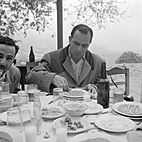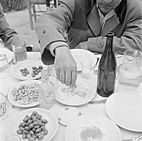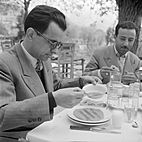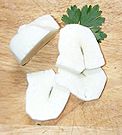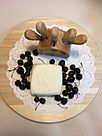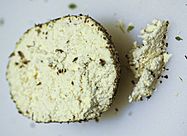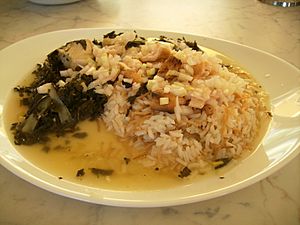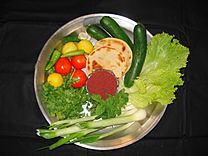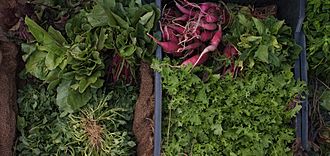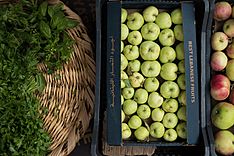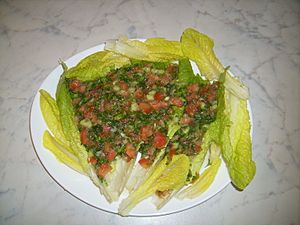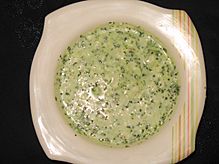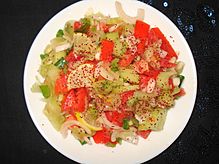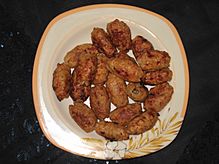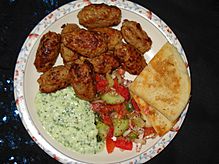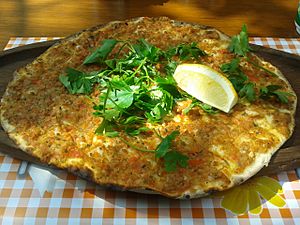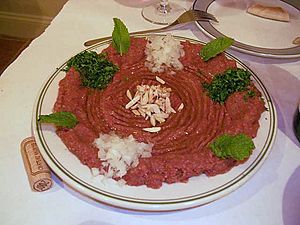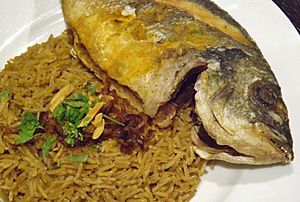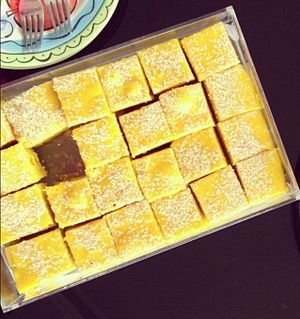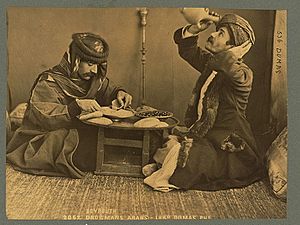Lebanese cuisine facts for kids
Lebanese cuisine is the culinary traditions and practices originating from Lebanon. It includes an abundance of whole grains, fruits, vegetables, fresh fish and seafood. Poultry is eaten more often than red meat, and when red meat is eaten, it is usually lamb and goat meat. Dishes include copious amounts of garlic and olive oil, and dishes are often seasoned with lemon juice. Chickpeas and parsley are also staples of the Lebanese diet.
Well-known dishes include baba ghanouj, tabbouleh, sfeeha, falafel and shawarma. An important component of many Lebanese meals is hummus, a chickpea puree dish, and many dishes are eaten with flatbread. Well-known desserts include baklawa, sfouf and ka'ak. Some desserts are specifically prepared on special occasions; for example, meghli (rice pudding dessert, spiced with anise, caraway, and cinnamon) is served to celebrate a newborn baby in the family.
Arak is an anise-flavoured liquor, and is the Lebanese national drink, usually served with a traditional convivial Lebanese meal. Another historic and traditional drink is Lebanese wine.
Contents
History
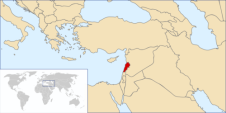
Lebanese cuisine has ancient roots and is part of the culinary tradition of the Eastern Mediterranean. Many dishes in Lebanese cuisine can be traced back thousands of years to eras of Phoenician, Persian, Egyptian, Neo-Babylonian, Roman, Greek, Byzantine, Arab and Ottoman rule. In the last 500 years, Lebanese cuisine has been influenced by the different foreign civilizations that held power. From 1516 to 1918, the Ottoman Turks controlled Lebanon and introduced a variety of foods that have become staples in the Lebanese diet, such as cooking with lamb. After the Ottomans were defeated in World War I (1914–1918), France took control of Lebanon until 1943, when the country achieved its independence. The French introduced foods such as flan, caramel custard, eclairs, french fries and croissants.
The Lebanese diaspora who live worldwide have introduced new ingredients, spices and culinary practices into Lebanese cuisine, keeping the cuisine innovative and renowned both beyond and within its borders.
Overview
Most often, foods are grilled, baked or lightly cooked in olive oil; butter or cream is rarely used other than in a few desserts. Vegetables are often eaten raw, pickled, or cooked. Like most Mediterranean countries, much of what the Lebanese eat is dictated by the seasons and what is available. Lebanese cuisine also varies by region. South Lebanon is famous for its kibbe, the Beqaa Valley for its meat pastries (such as sfiha), and north Lebanon and Saida (Sidon) for its sweets.
In Lebanon, very rarely are drinks served without being accompanied by food. Similar to the tapas of Spain, mezeluri of Romania and aperitivo of Italy, mezze is an array of small dishes placed before the guests creating an array of colors, flavors, textures and aromas. This style of serving food is less a part of family life than it is of entertaining and cafés.
Mezze may be as simple as raw or pickled vegetables, hummus, baba ghanouj and bread, or it may become an entire meal consisting of grilled marinated seafood, skewered meats and a variety of cooked and raw salads and an arrangement of desserts. The assortments of dishes forming the mezze are generally consumed in small bites using a piece of flatbread.
A typical mezze will consist of an elaborate variety of 30 or so hot and cold dishes, which may include:
- Salads such as tabbouleh and fattoush
- Dips like hummus, baba ghanoush and moutabal
- Kebbeh, kafta and falafel (fried chickpea balls)
- Some patties such as the sambusac
- Stuffed grape leaves and pickles
- Roasted nuts, olives and vegetables
- Condiments like toum and taratour, ideal for spread on sfiha
When dining as a family, the mezze typically consists of three or four dishes, but when served in the restaurant, the mezze can range from 20 to 60 dishes, as the variant combinations and dishes involved are plenty. Family cuisine also offers a range of dishes, such as stews (yakhneh) which can be cooked in many forms depending on the ingredients used and are usually served with meat and rice.
Although simple fresh fruits are often served towards the end of a Lebanese meal, there is also dessert, such as baklava and coffee. When sweets are not available, fruits are typically eaten after meals, including figs, oranges and other citrus fruits, apples, grapes, cherries and green plums (janarek). Although baklava is the most internationally known dessert, there is a great variety of Lebanese desserts.
Dishes and ingredients
Lebanese dishes are heavily influenced by the multiple civilisations that have existed within the region, which has accumulated together to form the modern Lebanese cuisine we know today. Using fresh, flavourful ingredients and spices, Lebanese cuisine combines Turkish, Arab, and French cooking styles. Characteristics include the use of lamb (introduced by the Ottomans); the abundant use of nuts (especially almonds and pine nuts), and dressings made from lemon juice.
Bread
The Lebanese use bread, usually flatbread, as an integral part of a meal and food is generally not served without it.
-
Pita bread with a pocket, known as khubz Arabi (Arab bread), is widely popular, and may be cut or torn up to dip in various dishes or be stuffed as a sandwich or wrap with ingredients such as falafel or shawarma.
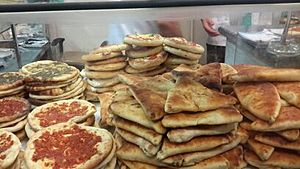 Variants of manaeesh and other bread presented in a Lebanese eatery
Variants of manaeesh and other bread presented in a Lebanese eatery - Taboon bread is traditionally baked in a taboon oven or a tannur, and is similar to the various tandoor breads found in many parts of Asia.
- Marquq is prepared much thinner, almost paper thin, and cooked on a metal saj or pan.
- Ka'ak is a common Lebanese street bread that is usually consumed as a snack. There are many variations of ka'ak, from being sprinkled with traditional sesame seeds to being stuffed with cheese and za'atar.
- Manaeesh (mini-pizza) is traditionally garnished with cheese (kashk, in its Lebanese version), za'atar, spicy diced tomatoes and may be eaten for breakfast. These are made in many variants in a number of local bakeries or furns. Some bakeries allow customers to bring their own toppings in order to build their own customized manaeesh for breakfast, lunch, and dinner. Variants include manakousheh za'atar (thyme pizza) and manakousheh jebneh which has only cheese.
- Manaeesh dough can also be eaten with minced meat and onions which is called lahm bi 'ajin. Mini versions are called sfeeha. The same dough can be made into a triangular pie called fatayer, filled with spinach, onions and sumac.
Dairy
Cheese, as well as yogurt and eggs, are commonly used in Lebanon. One of the more recognizable dishes within Lebanon is labneh. Unlike regular yogurt, labneh is strained so as to remove the watery whey, leaving a thicker, creamier consistency. It is spreadable and garnished with olive oil and sea salt. It is an extremely versatile dish that can be served in a mezze platter for either breakfast or dinner. A variant is mixed with garlic. Ejjeh is the traditional omelette of Lebanon. It is made with egg, chopped parsley and scallions. Within Lebanon, people make this omelette with different herbs that are cultivated from their village.
Cheeses
- Ackawi (also akkawi), is a salty white cheese made from pasteurized cow's milk but can also be made with goat's or sheep's milk.
- Baladi cheese has a mild yet rich flavor. It is called the "cheese of the mountains" since it is made in the high mountains by local shepherds in Lebanon.
- Feta is used in salads and other dishes, although some cooks will use a milder cheese called jibtieh baidha (simply "white cheese").
- Halloum is a semi-hard unripened cheese, perfect for grilling and frying. Along with akkawi it is traditionally stored in brine, giving it a strong, salty taste. (Though modern methods have allowed fresher varieties with less salt.)
- Kashkaval is a cheese popular in many Eastern European countries that has made its way into Lebanese cuisine. It melts very quickly and is practical for pasta, pizza and sandwiches.
- Nabulsi is similar to halloumi, made by boiling fresh ackawi cheese in a mixture of spices and seeds which are then fried, grilled or eaten and used in the popular dessert knafeh, a cheese pastry soaked in a sugar-based syrup.
- Shanklish is made from cow's milk, salted, fermented and seasoned with thyme and pepper, formed into cheese balls coated in red pepper chilli flakes.
Stews
Lebanese stews, often served with rice or flatbread, are made with ingredients found locally available.
-
Bamieh bi-zeit (okra and tomato stew) is one of the most popular stews. Traditionally, it is served with rice and a basic salad dressed with lemon juice and olive oil, with fresh warm bread. This stew combines the distinct flavor of okra with a flavourful tomato sauce.Lebanese mulukhiyah stew with chicken served with rice, vinegar onions and toasted pita bread
- Bamya bel lahmeh (okra and lamb stew) adds small sautéed pieces of filleted lamb.
- Abu shoushe is a taro and lentil stew.
- Yakhnet sabanikh is a spinach stew.
- Fasoulya hamanieh is a kidney bean stew.
- Makhlouta is made with a variety of beans, wheat, and legumes, and is popular in the town of Baskinta.
- Mulukhiyah is a stew with mallow leaves, chicken, beef topped with raw chopped onions, and vinegar.
- Mjadrat fasoulya kidney bean and lentil stew popular in Rashaya.
- Mloukhiye b'zeit is a dish In northern Lebanon made using fresh leaves and shoots of the Nalta jute plant, cooked with olive oil, onions, garlic, tomatoes and chilli peppers. It is a popular summer side dish, especially in Miniyeh-Danniyeh and Akkar districts.
- Mfaraket koussa (spicy zucchini stew) is one of the easiest and simplest ways to make use of the abundant summer zucchini.
- Daoud bacha is a meat-based stew, and consists of beef meatballs (also lamb) with cinnamon, parsley, and stuffed with pinenuts in a tomato sauce.
Vegetarian
Vegetarian cuisine plays an important role in the cuisine of Lebanon. Being located in the Levant, vegetables and herbs (wild or cultivated) are abundant in the fertile landscape and serve as a main base of the cuisine. For Lebanese Christians, including Catholic (Maronites and Melkites) and Orthodox, fasting from meat is practiced over the Lenten period (from midnight to noon) during Easter. Where abstention of meat is observed, the food is referred to as akl aateh (meaning food "cut" from the diet, such as meat or absent from meat). The particular food that is "cut" varies over different traditions.
Salads
- Fattoush (also called "peasants' salad") is made with pita, cucumbers, tomatoes, chickweed, and mint.
- Tabbouleh is a diced parsley salad with bulgur wheat, tomato, mint and served with lettuce, eaten within a mezze or as a standalone dish as a precursor to a main course.
- Yogurt cheese salad consists of shanklish balls (yogurt cheese, feta, chilli powder, thyme, cumin, salt and pepper) added to a freshly prepared salad. It is distinctively Lebanese as is a perfect addition for mezze, complimenting Arab and Lebanese wines.
Stuffed dishes
- Wara' enab is a dish commonly served as a mezze (appetizer), stuffed with either rice and meat or just rice.
- Kousa mahshi consists of various kinds of squash or zucchini stuffed with rice and sometimes meat and cooked on the stovetop or in the oven.
Chickpea-based dishes
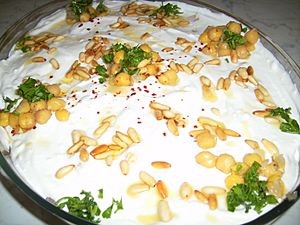
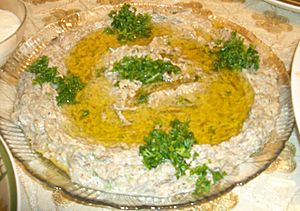
- Falafel is a dish of deep-fried balls or patties made of highly spiced ground chickpeas
- Hummus is a popular dip for pita bread made of blended chickpeas, sesame tahini, lemon juice, and garlic.
- Fateh b'hummus is a dish of chickpeas, flatbread pieces and spiced yogurt.
- Balila is a simple yet popular chickpea dish that has been boiled along with lemon juice, garlic and various spices.
Aubergine-based dishes
- Baba ghanouj is char-grilled aubergine, made with tahini, olive oil, lemon juice, and garlic puree.
- Mutabbel is mashed cooked aubergines and tahini, mixed with salt, pepper, olive oil, with anar seeds.
- Makdous is a stuffed aubergine dish served with olive oil.
- Fried aubergine is served alongside other fried vegetables including potatoes, cauliflower, courgettes (zucchinis), onions and tomatoes, usually referred to as a "mixed fry up".
- Fatteh is one of the most popular dishes in the Levant is and the popular variant fatet batinjan (aubergine casserole) is served with yoghurt, fried bread, aubergine, and maté.
- Moussaka unlike the Greek style is a vegetarian aubergine dish, made with fried aubergine simmered in an onion and tomato sauce with chickpeas.
Bean and legume dishes
- Ful (Lebanese-style) is a slow-cooked mash of fava beans, sometimes with chickpeas, dressed with lemon, olive oil, and cumin.
- Riz bil-foul is another dish with fava beans, seasoned with various spices and served with rice.
- Mujaddara (imjaddarra) is a popular dish found throughout the Middle East and consists of cooked lentils together with wheat or rice, garnished with sauteed onions.
Meats
Lebanese meat dishes are usually made with chicken or lamb, though pork is also eaten (albeit not as widely, due to Islamic dietary laws). However, meat is expensive everywhere and not always readily available. Meat was traditionally precious and usually served on the weekend. It is sometimes eaten mixed with bulgur to prolong the shelf life.
Mixed meat
- Shawarma is a commonly found form of street food made with slow-cooked skewered meat (either chicken, lamb or beef) that is thinly sliced and served as a sandwich with toppings such as onions, pickles and tomatoes. Styles of this dish include shawarma lahmeh, grilled meat with parsley, onion and tarator, and shawarma djeij which is grilled poultry with toum and lettuce.
- Sambousek (also called samboosak, or sambousak bi-lahm) is a small stuffed pastry often filled with meat and served as an appetizer (mezze). Though usually filled with ground beef or lamb, sambousek can also be filled with cheese or other fillings.
- Kibbeh is a filled bulgur dough made with ground meat and can be made in different forms including fried (kibbeh raas), uncooked (kibbeh nayyeh), baked (kibbeh bil-saneeya), and all may be served with yogurt. Some regional versions of kibbeh are a pumpkin-flavoured kebbe lakteen (popular in Beit Mery) and kebbe zghartweih which is an oven-cooked version popular in Ehden.
- Kubideh is a type of kebab served with pivaz, a relish made of minced parsley, onions, ground cumin and sumac.
- Kafta is made with spiced ground meat that is shaped into small patties or rolled into meatball-shaped balls which are then baked, pan-fried or charcoal-grilled on skewers. Kafta is served with bread and other side dishes.
Lamb
- Habra (raw lamb fillet) is essential for most dishes involving lamb. It is the foundation for many popular dishes including kibbeh nayyeh (minced raw lamb) and other variants of kibbeh. The fillet needs to be prepared and chilled for a minimum of 2 hours, and can even be prepared one day in advance.
- Dehen, somewhat like a meat shortening made from lamb-tail fat, fried lamb pieces and spices, is often used to give dishes a light meaty flavour without the expense of bulk meat.
- Barout del batata is spicy lamb served with potatoes.
- Deleh mehshi is a stuffed rib cage of lamb (popular in Broummana).
- Laban immo is cooked yoghurt and lamb with rice (popular in Douma).
- Kafta meshwi is minced lamb mixed with finely chopped onion and parsley, broiled on a skewer over charcoal.
- Qawarma originates from a centuries-old custom that was to buy a fat-tailed lamb in the spring and force-feed it day and night with mulberry and grape leaves, wheat hulls and other ingredients ending in a succulent chopped lamb dish, salted and kept in the grease of the animal.
- Sfiha (also lahm b'ajin) are pastries covered with mutton minced meat, onions, and nuts popular in the Lebanese town of Baalbek.
- Shish barak (Lebanese ravioli) is meat dumplings in yogurt sauce.
- Khash is a dish of boiled sheep parts, which might include the head, feet, and stomach (tripe).
Chicken
- Chich taouk is charcoaled grilled chicken marinated with garlic, lemon, and spices including cinnamon and cumin
- Djaj meshwi is grilled spiced chicken on bbq, marinated with a garlic lemon sauce.
- Farrouj meshwi is grilled chicken, served with garlic sauce.
- Jwenih (or Jawaneh) are chicken wings cooked with coriander, garlic and lemon, served as mezze.
- Riz bi-djaj is a dish of chicken and rice.
- Shish taouk is grilled chicken skewers that utilize only white meat, marinated in olive oil, lemon, parsley, and sumac, served on a bed of rice with almonds and pine nuts.
Beef
- Pastirma is cured, seasoned dried beef, introduced by the Ottomans.
- Tabbouleh bi dehn is another version of tabbouleh and is cooked with lentils and beef ghee.
- Ghameh is a delicacy of stuffed cow intestines.
- Kafta bithine is spiced meat with sesame concentrate, popular in Beit ed-Dine.
- Kafta nayyeh is raw beef tartarre.
Fish
- Samkeh harra is grilled fish that has been marinated with chili, citrus, and cilantro.
- Akhtabout is grilled octopus (usually served with samkeh harra in Beirut).
- Sayadieh is delicately spiced fish served on a bed of rice. Fish cooked in saffron and served on rice with onions, sumac, and a tahini sauce (the most important part of the dish), originated in Sidon.
Sweets
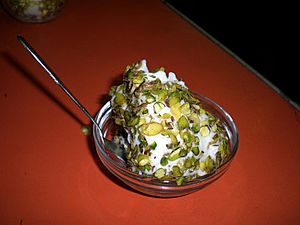
The modern form of Lebanese desserts have been influenced by Ottoman cuisine and share many similarities with other neighbouring countries. Semolina is used in the preparation of several prominent Lebanese desserts.
- Muhallebi is a milk pudding made with rice, milk and sugar. Like many other Lebanese desserts, it is sweetened with attar syrup and served with a garnish of assorted nuts.
- Barazeh (also found in Syrian cuisine), are cookies with a light and crumbly texture; one side is decorated with sesame seeds and the other side with pistachios.
- Ma'amoul are crumbly cookies filled with pistachios, walnuts or dates. Lebanese Christians serve ma'amoul with atar syrup for Easter, as well as a cake flavored with anise and mahlab.
- Halawet el jibn is filled with sweetened cheese and topped with atar, pistachios, clotted cream (ashta) and rose jam.
- Baklawa is made of a layered pastry filled with nuts and steeped in attar syrup (orange or rose water and sugar), usually cut into a triangular or diamond shape when served, which is the particular style that originated in Lebanon.
- Znoud al-sit is a syrup-soaked rolled pastry filled with clotted cream and garnished in typical fashion with nuts, orange peels and dates to the 19th century.
- Kanafeh is a dessert stuffed with white cheese (such as akkawi cheese), nuts and syrup made with made with kadayif dough.
- Karabij (or aleppo cookies), flavored with mahlab and cinnamon, topped with natef, which is similar to meringue.
- Mafroukeh is a semolina dough layered with caramel and butter, soaked in atar and served with clotted cream and assorted nuts. It can also be used to make cakes like nammoura.
- Sfouf is a cake made with semolina flour and turmeric. It is cake consumed on birthdays, family reunions, and religious holidays.
- Booza is a type of ice-cream commonly referred to as Arabic ice cream, and is filled with Middle Eastern aromas. It is traditionally made through a process of pounding and stretching in a freezer drum, instead of the more usual churning method used in other ice creams. Lebanese ice cream is popular with its eastern flavors, including amar al-din made from dried apricot paste.
Condiments and spices

- Tahini – sesame paste.
- Tarator – tahini, water, garlic and lemon dip.
- Toum – garlic sauce.
- Shatta – chili sauce popular in the Middle East.
- Muhammara – muhammara or mhammara is a hot pepper dip originally from Aleppo, Syria, found in Levantine and Turkish cuisines.
- Sumac – a tangy spice used in many salads.
- Za'atar – dried thyme and sumac that can differ from region to region and from family to family. Most are made in house, but can be bought at Lebanese larders.
- Lebanese spice blend (also called Lebanese seven spice) – a mixture of equal parts of allspice, black pepper, cinnamon, cloves, fenugreek, nutmeg and ginger. It is commonly used to flavor many Lebanese dishes.
Beverages
- Arabic coffee, black coffee and Turkish coffee.
- Lebanese beer, also contains non-alcoholic versions made with malt instead of hops.
- Arak – an alcoholic beverage.
- Ayran – yogurt.
- Non-alcoholic beverage made from the carob tree.
- Jallab – sweet drink made from carob, dates, grape molasses and rose water.
- Lebanese wine – Lebanon is among the oldest sites of wine production in the world. The Phoenicians of its coastal strip were instrumental in spreading wine and viticulture throughout the Mediterranean in ancient times. Lebanon's Beqaa Valley contains more than 30 vineyards, including the renowned Kefraya, Ksara and Château Musar labels.
- Mate – a caffeine-rich infused drink and is consumed frequently in Shouf and Aley. It was thought to have been brought from Argentina by immigrants in the Lebanese diaspora returning home, where its important ingredients are grown.
See also
 In Spanish: Gastronomía del Líbano para niños
In Spanish: Gastronomía del Líbano para niños


